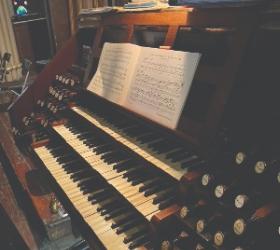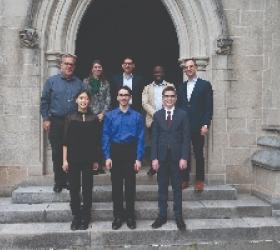
Glück New York,
New York, New York
Leon Lowenstein Memorial Auditorium, Congregation Emanu-El, New York, New York
The Fox Memorial Pipe Organ began its career as M. P. Möller’s Opus 9718 of 1962, designed by Dr. Robert S. Baker in collaboration with John H. Hose, tonal director of the Möller firm. The instrument was installed behind draperies in the amphitheatre choir loft of the 1,100-seat auditorium, which is designed to transform from a concert and lecture venue into a fully equipped summer sanctuary. Only the 16' Contrebasse and 16' Hélicon are partially visible from the auditorium. The placement of the instrument near the choir’s microphones (also used for radio broadcasts) forced an unhappy situation of under-scaled and feebly winded pipes, with closed toe holes and mouth heights as low as 1/6 cut-ups.
After 45 years, the temple contracted with Glück New York to tonally redesign the instrument and replace its mechanical systems. The solid-state drawknob console retains the original ivory keyboards and tiger maple pedalboard. The organ’s remote pneumatic relays and combination stacks were replaced with solid-state equipment.
The new tonal design moved from a typical American church organ of the period toward a warmer, fuller, rounder sound. Some of the mid-century tonal concepts that were of no use in the synagogue service (such as the two pseudo-baroque 4' reeds) were replaced by voices more essential to the liturgy. Many of the flue pipes had been left with untreated languids and were cut up only high enough to get them to speak. Furthermore, they had not had their toe holes opened, and could be considered essentially new and unvoiced, an added bonus in the context of the project. The unusual Shofar stop was designed by W. Adolph Zajic (1909–1987) and built with only six pipes; the organ’s new relay is prepared to fill out the stop in the future.
The new specifications were drawn up by Sebastian M. Glück, artistic and tonal director of the firm, who also carried out the voicing and tonal finishing. Albert Jensen-Moulton, general manager, was responsible for all technical aspects of the project. The three other pipe organs in the temple complex include a IV/135 in the sanctuary and a III/35 in Beth-El Chapel, both by the Glück firm. A fourth pipe organ, a II/7 Wilfred Lavalée in Greenwald Hall, was removed in the 1990s.
—Sebastian M. Glück
Fox Memorial Pipe Organ
Leon Lowenstein Memorial Auditorium, Congregation Emanu-El, New York, New York
GRAND-ORGUE
Manual II, unenclosed, 31'4' wind
16' Bourdon
8' Montre
8' Bois ouverte
8' Violon sourdine
4' Prestant
2' Doublette
Plein jeu IV
8' Shofar
Tremblant
Jeux empruntés:
8' Bourdon (Pos)
8' Voix angélique (Pos)
8' Voix mystique (Pos)
4' Flûte (Pos)
8' Hautbois (Réc)
RÉCIT-EXPRESSIF
Manual III, enclosed, 4' wind
8' Viole de gambe
8' Voix céleste
8' Flûte à cheminée
4' Prestant
4' Flûte harmonique
2' Flûte à bec
Fourniture III
16' Basson
8' Trompette
8' Hautbois
Tremblant
8' Trompette de fête (Pos)
POSITIF-EXPRESSIF
Manual I, enclosed, 4' & 6' wind
8' Violon sourdine (G-O)
8' Voix angélique
8' Voix mystique
8' Bourdon
4' Prestant (prep)
4' Flûte
22'3' Nazard
2' Quart de nazard
13'5' Tierce
8' Clarinette
Tremblant
8' Trompette de fête
PÉDALE
Unenclosed, 4' wind
16' Contrebasse
16' Sous basse
16' Violoncelle sourdine (ext G-O)
16' Bourdon (G-O)
8' Octavebasse
8' Flûte
8' Bourdon (Pos)
8' Violon sourdine (G-O)
4' Quinzième
4' Cor de nuit
Mixture II
32' Aliquots graves
16' Hélicon
16' Basson (Réc)
8' Trombone
8' Basson (Réc)
Fabry, Inc., Antioch, Illinois
Immanuel Presbyterian Church, Milwaukee, Wisconsin
Located in one of the oldest neighborhoods in Milwaukee, Immanuel Presbyterian Church has held a place of honor on Yankee Hill, overlooking Lake Michigan. In 1881 the church purchased what is now the core of the present instrument. Nearly all of the unison voices and lower are from the original instrument, including the 16' Double Open Diapason and 16' Principal, both of which are wood. During the next 120 years, additions and rebuilds occurred, bringing the instrument to its current state, still preserving over 75% of the original instrument. In 1965, the organ was fitted with a used Austin three-manual console. While the console worked well for a time, it was clear a new console was needed. When Fabry, Inc. was contacted to do the work, the previous curator had left many parts, tools and pipes in the organ area. Among these items was an 8' French Horn, purchased by the church and awaiting installation.
Fabry, Inc. undertook the following to improve the usability and tonal palette of the organ. An all-new three-manual drawknob console was custom crafted by David G. Fabry to control the 67-rank, 71-stop instrument. Utilizing the ICS-4000 combination action and relay system, this console and interface brings the 1881 Hook & Hastings into the 21st century. The aforementioned French Horn received a new chest built by David G. Fabry, and was installed in the String division with its own dedicated electric tremolo. A new electric extension of the 16' Bassoon in the Swell was installed, fully utilizing this rescaled 8' stop to a greater degree. Other smaller jobs, such as bracing and reworking the ventilation system were also completed at this time. While one half of the organ had been re-wired with PVC-coated wiring, the other half was brought up to standard.
Fabry, Inc. would like to thank the Rev. Deborah A. Block, pastor; Steven J. Jensen, organist; and John S. Komasa, director of music.
—Phil Spressart
GREAT
16' Open Diapason
16' Bourdon
8' Open Diapason
8' Chimney Flute
8' Doppel Flute
8' Aeoline (TC)
8' Gamba
8' Gemshorn
4' Octave
4' Harmonic Flute
22'3' Twelfth
2' Fifteenth
2' Waldflöte
2' Mixture IV
16' Double Trumpet
8' Trumpet
8' Tuba Mirabilis (Ped)
4' Clarion
Cathedral Chimes
Great 4
Great Unison Off
Great 16
SWELL
16' Lieblich Gedeckt
8' Open Diapason
8' Stopped Diapason
8' Viole d’Gambe
8' Viole Celeste
4' Octave
4' Flute Traverso
22'3' Nazard
2' Flautino
13'5' Tierce
11'3' Plein Jeu III
16' Bassoon (1–12 elec.)
8' Hautbois
8' Trumpet
8' Vox Humana
4' Clarion
Tremolo
Swell 4
Swell Unison Off
Swell 16
CHOIR
8' Geigen Principal
8' Melodia
8' Viol d’Amour
8' Viol Celeste
4' Octave
4' Stopped Flute
2' Piccolo
11'3' Larigot
22'3' Mixture II
8' Clarinet
8' Tuba Mirabilis (Ped)
8' Harp Celeste
Mockingbird
Cymbelstern
Tremolo
Choir 4
Choir Unison Off
Choir 16
STRING
8' Dulciana
8' Violon Cello
8' Cello Celeste
8' Violin Sordo
8' Violin Celeste
8' French Horn
Tremolo
PEDAL
32' Violone (1–12 elec.)
32' Contra Bourdon (1–12 elec.)
16' Double Open Diapason
16' Principal
16' Bourdon
16' Lieblich Gedeckt (Sw)
16' Violone (Gt)
8' Octave
8' Bass Flute
8' Holzgedeckt
8' Violin Cello
4' Fifteenth
2' Mixture III
32' Bombarde (1–12 elec.)
32' Contra Trombone
16' Bassoon (Sw)
16' Double Trumpet (Gt)
16' Trombone
8' Tromba
4' Tromba




